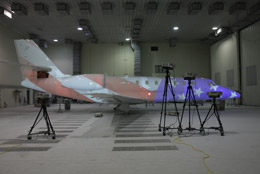Take the Guesswork Out of Complex Assemblies

PaintWorks uses optical projection to project the image onto an aircraft before it is painted.
Producing a high-quality product at a reasonable cost requires a balance of speed, accuracy, and efficiency. For complex assembly operations, this balancing act can be especially challenging. In the aerospace industry, for example, technicians must read and carry out many sets of work instructions to assemble even one component. Today, more companies than ever are using visual aids, mylars, and other new technologies to get the most efficiency out of their work cells.
Laser vs. optical
Laser projection, which uses lasers to project a 3D template onto materials to serve as a guide during the manufacturing process, has helped to make this process easier and more efficient. However, the technology can have drawbacks as compared to optical solutions:
- Optical projections are better at reproducing photos and solids.
- Optical projection can produce unlimited text and colors.
- Optical projections don’t flicker.
This was the catalyst for creating the ProjectionWorks product line. While the laser projection market was rapidly growing, nobody in the industry had brought an optical solution to the market. ProjectionWorks solutions create optical projections that complement existing laser technology or provide an alternative to it. This technology eliminates the “knowledge gap”: the introduction of errors during the transfer of knowledge from 2D instructions to the actual assembly.
Perfect projection
Since 1990, DSC has worked on research and development (R&D) for military and aerospace products. These decades of experience led to the development of the ProjectionWorks products:
- AssemblyWorks provides assembly and inspection instructions. This combination of hardware and software can display the assembly information that technicians need for a variety of tasks. The data is displayed exactly where it’s needed, in a predetermined, optimal-build sequence.
- PaintWorks provides paint-scheme viewing and masking instructions. The PaintWorks computer system can connect to an unlimited number of projectors to accurately project a paint scheme onto the object.
- HarnessWorks, which will be available in 2015, will provide wire-harness assembly instructions. The product will project step-by-step instructions from design software onto the harness board.
- PatternWorks, which will be available in 2015, will provide kit presentation for nested cut or stamped material.
ProjectionWorks uses DSC’s patented calibration method to orient the 3D projector to the manufactured object. The projector is attached to a host computer, which uses a high-resolution camera to scan the object. The scan detects unique features on the object and correlates them to the object’s CAD data. This allows each projector to lock into the coordinate system of the object so that the projections appear right where they are needed.
Groundbreaking technology
DSC received the ManTech award in 2012 for its groundbreaking ProjectionWorks optical projection technology. The award is given by the Department of Defense once a year to the technology that presents the greatest benefit to the American taxpayers and warfighters. ProjectionWorks products are helping aircraft manufacturers complete complex assembly tasks faster, with fewer errors and lower labor costs — and they can do the same for your production operations. For example, the U.S. Air Force reported an expected ROI of more than 4,000% after implementing the solution on its F-35 assembly line.
[cta]In today’s global economy, work moves to the vendor that can produce the best products at the best price and on the best timeline. To discover how ProjectionWorks can improve your production processes and reduce costs and errors, call DSC at (770) 575-5100 or email info@deltasigmacompany.com.[/cta]

